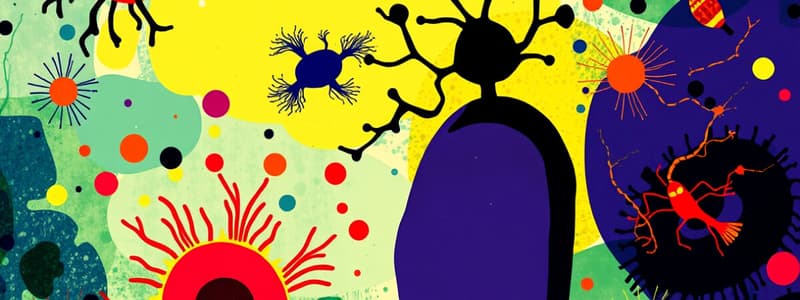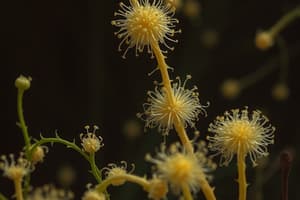Podcast
Questions and Answers
What is Microbiology?
What is Microbiology?
- The study of mammals
- The classification of plants
- Specialized area of biology that deals with organisms ordinarily too small to be seen without magnification (correct)
- The study of cells
What are microorganisms?
What are microorganisms?
A living thing ordinarily too small to be seen without magnification.
What is classification?
What is classification?
Orderly arrangement of organisms into groups.
What is nomenclature?
What is nomenclature?
What is binomial nomenclature?
What is binomial nomenclature?
What are acellular organisms?
What are acellular organisms?
What are cellular organisms?
What are cellular organisms?
What defines prokaryotes?
What defines prokaryotes?
What defines eukaryotes?
What defines eukaryotes?
What is binary fission?
What is binary fission?
What is mycology?
What is mycology?
What is phycology?
What is phycology?
What is a pathogen?
What is a pathogen?
What is genetic engineering?
What is genetic engineering?
What is recombinant DNA?
What is recombinant DNA?
What are lactic acid bacteria used for?
What are lactic acid bacteria used for?
What are curds?
What are curds?
What is whey?
What is whey?
What does rennin do?
What does rennin do?
What is curdling?
What is curdling?
What is the scientific method?
What is the scientific method?
What is a hypothesis?
What is a hypothesis?
What is a theory?
What is a theory?
What is spontaneous generation?
What is spontaneous generation?
What is cell theory?
What is cell theory?
What is biogenesis?
What is biogenesis?
What general metabolic process used by microbes aids in food production?
What general metabolic process used by microbes aids in food production?
What is pasteurization?
What is pasteurization?
What is the germ theory of disease?
What is the germ theory of disease?
What are Koch's postulates?
What are Koch's postulates?
What is aseptic technique?
What is aseptic technique?
What is chemotherapy?
What is chemotherapy?
What are synthetic drugs?
What are synthetic drugs?
What are antibiotics?
What are antibiotics?
What is the general size of macroscopic organisms?
What is the general size of macroscopic organisms?
What is the size range of microscopic organisms?
What is the size range of microscopic organisms?
What is the size of viruses?
What is the size of viruses?
What are the 3 domains used in the Woese-Fox system of classification?
What are the 3 domains used in the Woese-Fox system of classification?
Which domain are fungi members of?
Which domain are fungi members of?
Which domain do Protozoa belong to?
Which domain do Protozoa belong to?
Which domain are Algae in?
Which domain are Algae in?
Which domain does E. coli belong to?
Which domain does E. coli belong to?
Which domain do viruses belong to?
Which domain do viruses belong to?
What are bacteria?
What are bacteria?
What defines algae?
What defines algae?
What defines fungi?
What defines fungi?
What are protozoa?
What are protozoa?
Name 3 cellular structures protozoa use for locomotion.
Name 3 cellular structures protozoa use for locomotion.
What are the beneficial roles of microorganisms?
What are the beneficial roles of microorganisms?
How do microbes affect the world?
How do microbes affect the world?
What is morphology?
What is morphology?
What is physiology in microbiology?
What is physiology in microbiology?
What is taxonomy?
What is taxonomy?
What is bacteriology?
What is bacteriology?
What is microbial ecology?
What is microbial ecology?
What is a culture?
What is a culture?
What is isolation in microbiology?
What is isolation in microbiology?
What is incubation?
What is incubation?
What is inspection in microbiology?
What is inspection in microbiology?
What is identification in microbiology?
What is identification in microbiology?
What is inoculum?
What is inoculum?
What is liquefiable growth media?
What is liquefiable growth media?
What is nonliquefiable media?
What is nonliquefiable media?
What is agar?
What is agar?
What is synthetic/defined growth media?
What is synthetic/defined growth media?
What is complex growth media?
What is complex growth media?
What is general purpose growth media?
What is general purpose growth media?
Study Notes
Microbiology Overview
- Microbiology studies organisms too small to be seen without magnification, focusing on microorganisms.
- Microorganisms include bacteria, viruses, fungi, algae, and protozoa.
Classification and Nomenclature
- Classification involves the orderly arrangement of organisms into groups.
- Nomenclature assigns names to organisms, following the binomial system (Genus and species, italicized).
- Genus names are capitalized, while species names are not.
Cell Types
- Acellular organisms (e.g., viruses) lack cellular structure.
- Cellular organisms are categorized into prokaryotes (no enclosed nucleus) and eukaryotes (nucleus present).
Prokaryotes vs. Eukaryotes
- Prokaryotic cells are smaller and lack organelles, while eukaryotic cells contain a nucleus and specialized organelles.
- Prokaryotes include all bacteria; some eukaryotes (like molds and yeast) are also microbes.
Reproduction and Growth
- Binary fission is the reproduction method for bacteria, splitting a parent cell into two.
- Culturing involves inoculation, incubation, isolation, inspection, and identification of microbes.
Microbial Studies
- Mycology: study of fungi.
- Phycology: study of algae.
- Protozoology: study of protozoa.
- Virology: study of viruses.
Pathogens and Disease
- Pathogens are agents of disease; the germ theory of disease suggests microbes cause illness.
- Koch's postulates establish criteria for linking specific microbes to diseases.
Fermentation and Food Production
- Fermentation is the metabolic process converting sugars to acids or alcohols, essential in food production (e.g., yogurt, cheese).
- Lactic acid bacteria play a significant role in dairy fermentation, producing distinct flavors.
Pasteurization and Food Safety
- Pasteurization kills most microorganisms in food through heat but may not eliminate all spoilage organisms.
- Aseptic techniques reduce microbial presence in clinical settings to prevent infections.
Microbial Ecology and Beneficial Roles
- Microbes contribute to nutrient cycling, ecosystem dynamics, and human health (normal flora).
- They aid in digestion, produce oxygen, and serve as sources of antibiotics and vaccines.
Key Figures in Microbiology
- Hooke: Coined "cell."
- Pasteur: Developed aseptic techniques; contributed to germ theory and vaccines.
- Jenner: Created vaccination for smallpox.
- Fleming: Discovered penicillin.
Major Theories of Life Emergence
- Cell theory states all living things are composed of cells.
- Biogenesis refers to life arising from existing life.
- Spontaneous generation suggests life can arise from nonliving matter.
Microbial Size and Classification
- Macroscopic organisms are approximately 1 mm or larger.
- Microscopic organisms measure 1 µm to 100 µm, while viruses range from 10 nm to 100 nm.
- Woese-Fox classification divides life into three domains: Bacteria, Archaea, and Eukarya. Fungi, protozoa, and algae fall under Eukarya.
Microbial Culture Techniques
- Media include liquefiable (e.g., agar) and non-liquefiable media (e.g., potato slices).
- Growth media can be synthetic (chemicals known) or complex (exact chemical makeup unknown).
- General-purpose media supports the growth of a broad range of microorganisms.
Modern Applications and Challenges
- Genetic engineering manipulates microbial genetics for new products; recombinant DNA technology creates modified organisms.
- Antibiotic resistance poses challenges in chemotherapy, which uses chemical substances to treat diseases.
Studying That Suits You
Use AI to generate personalized quizzes and flashcards to suit your learning preferences.
Description
Prepare for your Microbiology Exam 1 with these flashcards covering essential concepts from Chapters 1, 3-5. Learn definitions and key terms related to microbiology and microorganisms that are vital for your understanding of the subject.




